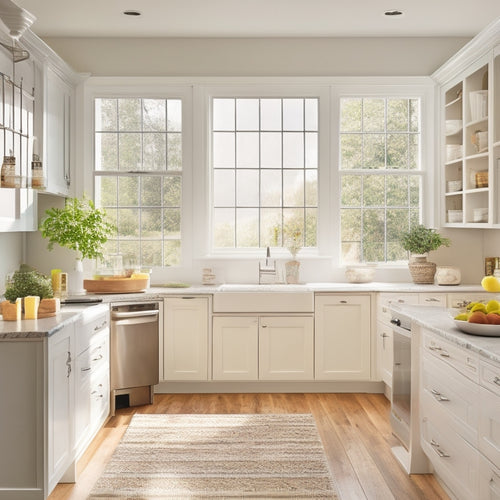
Why a Custom Kitchen Matters for Allergy Families
Share
Having a custom kitchen designed with allergy considerations in mind can be a game-changer for your family. You'll be able to proactively minimize cross-contamination risks, simplify meal preparation, and create a safe and inclusive space for everyone. A thoughtfully designed kitchen allows you to designate specific areas for allergenic ingredients, assign dedicated cabinets and shelves, and establish containment protocols. By streamlining meal prep and cleanup, you'll reduce stress and anxiety, and stay in control and confident. By optimizing your kitchen, you'll reveal a safe haven where everyone can feel included and empowered to cook with confidence - and that's just the beginning.
Key Takeaways
• A custom kitchen allows for strategic design elements to minimize cross-contamination risks and ensure a safe cooking environment for allergy families.
• Custom storage solutions can be implemented to separate and contain allergenic ingredients, reducing the risk of accidental exposure.
• A tailored kitchen layout can streamline meal preparation and cleanup, reducing stress and anxiety for families with allergies.
• A custom kitchen can accommodate diverse dietary needs, providing a sense of inclusion and safety for all family members.
• By incorporating soothing colors, minimal clutter, and ample natural light, a custom kitchen can create a calm and peaceful atmosphere for mindful cooking.
Designing for Safety and Inclusion
When designing a custom kitchen for an allergy-prone family, you must prioritize safety and inclusion by incorporating features that minimize cross-contamination, simplify meal preparation, and accommodate diverse dietary needs. By doing so, you'll create a space where everyone can feel included and safe.
To achieve this, consider personalized ergonomics, such as adjustable countertops and sink heights, to guarantee that each family member can comfortably prepare meals.
Vital accessibility is also essential. Widen walkways and install roll-out shelves to make it easy for everyone to navigate the kitchen, regardless of mobility. Additionally, incorporate multi-level countertops, which allow family members of different heights to work together comfortably.
Managing Cross-Contamination Risks
You can greatly reduce cross-contamination risks in your custom kitchen by implementing strategic design elements and smart storage solutions. By doing so, you'll create a safe space for your family to cook and enjoy meals together, free from the worry of accidental exposure.
One effective approach is to incorporate separation strategies, such as designating specific zones for food preparation, cooking, and storage. This can be achieved through the use of separate countertops, sinks, and appliances for each zone.
Containment protocols are also vital in preventing cross-contamination. Consider installing sealed storage containers, airtight bins, and enclosed shelves to keep allergenic ingredients and prepared foods isolated from other kitchen items.
Additionally, consider the flow of traffic in your kitchen, ensuring that high-risk areas, such as food prep zones, are situated away from frequently used pathways.
Optimizing Storage for Allergens
Designating a specific storage area for allergenic ingredients is essential, and assigning a dedicated cabinet or shelf, easily accessible yet out of the way, can help prevent accidental exposure. This is especially important for common allergens like nuts, gluten, and dairy. By creating an 'Allergen Zone' in your kitchen, you can minimize the risk of cross-contamination and establish a safe cooking environment.
Here are some smart storage ideas to contemplate:
| Storage Solution | Benefits | Tips |
|---|---|---|
| Dedicated Cabinet | Keep allergens separate from other ingredients | Label the cabinet to avoid mistakes |
| Smart Shelves | Easily accessible and visible | Use baskets or bins to contain allergens |
| Pull-Out Drawers | Store allergens in a contained space | Consider using a drawer organizer |
| Sealed Containers | Prevent airborne allergens from spreading | Label containers with contents and date |
Streamlining Meal Prep and Cleanup
By implementing a few strategic tweaks to your meal prep and cleanup routine, you can reduce the risk of cross-contamination and make cooking for allergy families a whole lot easier. Establishing a smooth workflow in the kitchen is essential when managing food allergies. Efficient meal prep and cleanup not only save time but also minimize the risk of exposure to allergens.
Here are some cooking hacks to help you streamline your meal routines:
-
Designate a prep area: Set aside a specific zone for preparing allergy-friendly meals to avoid cross-contamination with other foods.
-
Use separate utensils and equipment: Reserve specific tools, such as cutting boards and knives, for allergy-friendly meal prep to prevent accidental exposure.
-
Label and date leftovers: Clearly label and date leftovers to make sure you know what's safe to consume and how long it's been stored.
- Clean as you go: Clean up spills and crumbs immediately to prevent allergens from spreading throughout the kitchen.
Creating a Calm Cooking Environment
A clutter-free kitchen space can greatly reduce stress and anxiety when cooking for allergy families, allowing you to focus on safely preparing meals. You'll feel more in control and confident in your ability to manage food allergies.
A calm cooking environment is essential for mindful cooking, which is critical when dealing with life-threatening allergies. By creating a sensory-friendly space, you'll be better equipped to handle the demands of allergy-friendly cooking.
Consider incorporating soothing colors, minimal clutter, and ample natural light to create a peaceful atmosphere. This, in turn, will help you stay focused and attentive to the cooking process, reducing the risk of cross-contamination and other mistakes.
Frequently Asked Questions
Can a Custom Kitchen Accommodate Multiple Allergy Types Simultaneously?
You can rest assured that a custom kitchen can indeed accommodate multiple allergy types simultaneously by incorporating designated Cross Contamination Zones and implementing Multi Allergen Solutions, ensuring a safe and inclusive cooking environment for everyone.
How Do I Balance Aesthetics With Allergy-Friendly Materials and Design?
Imagine a puzzle, where each piece represents a design element; you're the master puzzle-solver, balancing aesthetics with allergy-friendly materials and design. You'll find harmony by making intentional material choices and embracing design compromise, creating a kitchen that's both beautiful and safe.
Are There Any Allergy-Specific Certifications for Kitchen Designers and Builders?
You'll find industry-recognized certifications, like the Certified Kitchen Designer (CKD) or Certified Bath Designer (CBD), that demonstrate expertise in meeting certification standards, ensuring your designer or builder is knowledgeable about allergy-friendly materials and design.
Can a Custom Kitchen Be Designed for Renters, Not Just Homeowners?
You can design a custom kitchen as a renter, considering rent-friendly options that cater to your needs. Be mindful of lease limitations, and opt for modular or removable fixtures to guarantee a smooth shift when you move out.
How Much Extra Does a Custom Allergy-Friendly Kitchen Typically Cost?
You'll be shocked to know that 1 in 10 households has a food allergy, and a custom kitchen can be a game-changer. When budgeting for a custom allergy-friendly kitchen, expect to pay 10-20% more, with surprises like specialized cabinetry and ventilation adding to the overall cost breakdown.
Related Posts
-

Stockpile Essentials: Must-Have Items for Home
I keep my home stocked with essentials to avoid last-minute trips and guarantee smooth daily operations. I prioritize...
-

Corner Kitchen Storage Solutions to Boost Efficiency
To boost efficiency in your kitchen, you'll want to strategically utilize corner storage solutions. Start by measurin...
-

Deighton Associates Awarded for Excellence in Asset Management
You're likely curious about Deighton Associates' recent recognition for excellence in asset management. They've recei...


